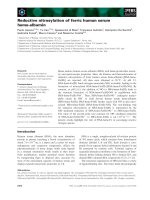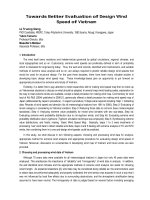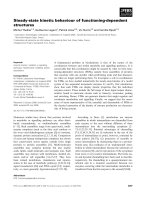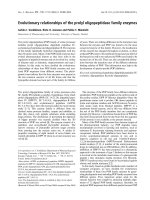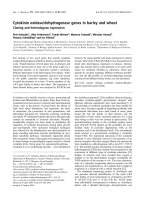Tài liệu Báo cáo khoa học: "Towards Tracking Semantic Change by Visual Analyti cs" docx
Bạn đang xem bản rút gọn của tài liệu. Xem và tải ngay bản đầy đủ của tài liệu tại đây (322.14 KB, 6 trang )
Proceedings of the 49th Annual Meeting of the Association for Computational Linguistics:shortpapers, pages 305–310,
Portland, Oregon, June 19-24, 2011.
c
2011 Association for Computational Linguistics
Towards Tracking Semantic Change by Visual Analytics
Christian Rohrdantz
1
Annette Hautli
2
Thomas Mayer
2
Miriam Butt
2
Daniel A. Keim
1
Frans Plank
2
Department of Computer Science
1
Department of Linguistics
2
University of Konstanz
Abstract
This paper presents a new approach to detect-
ing and tracking changes in word meaning by
visually modeling and representing diachronic
development in word contexts. Previous stud-
ies have shown that computational models
are capable of clustering and disambiguat-
ing senses, a more recent trend investigates
whether changes in word meaning can be
tracked by automatic methods. The aim of our
study is to offer a new instrument for inves-
tigating the diachronic development of word
senses in a way that allows for a better under-
standing of the nature of semantic change in
general. For this purpose we combine tech-
niques from the field of Visual Analytics with
unsupervised methods from Natural Language
Processing, allowing for an interactive visual
exploration of semantic change.
1 Introduction
The problem of determining and inferring the sense
of a word on the basis of its context has been the
subject of quite a bit of research. Earlier investiga-
tions have mainly focused on the disambiguation of
word senses from information contained in the con-
text, e.g. Sch
¨
utze (1998) or on the induction of word
senses (Yarowsky, 1995). Only recently, the field
has added a diachronic dimension to its investiga-
tions and has moved towards the computational de-
tection of sense development over time (Sagi et al.,
2009; Cook and Stevenson, 2010), thereby comple-
menting theoretical investigations in historical lin-
guistics with information gained from large corpora.
These approaches have concentrated on measuring
general changes in the meaning of a word (e.g., nar-
rowing or pejoration), whereas in this paper we deal
with cases where words acquire a new sense by ex-
tending their contexts to other domains.
For the scope of this investigation we restrict our-
selves to cases of semantic change in English even
though the methodology is generally language in-
dependent. Our choice is on the one hand moti-
vated by the extensive knowledge available on se-
mantic change in English. On the other hand, our
choice was driven by the availability of large cor-
pora for English. In particular, we used the New
York Times Annotated Corpus.
1
Given the variety
and the amount of text available, we are able to track
changes from 1987 until 2007 in 1.8 million news-
paper articles.
In order to be able to explore our approach in a
fruitful manner, we decided to concentrate on words
which have acquired a new dimension of use due
to the introduction of computing and the internet,
e.g., to browse, to surf, bookmark. In particular,
the Netscape Navigator was introduced in 1994 and
our data show that this does indeed correlate with a
change in use of these words.
Our approach combines methods from the fields
of Information Visualization and Visual Analyt-
ics (Thomas and Cook, 2005; Keim et al., 2010)
with unsupervised techniques from Natural Lan-
guage Processing (NLP). This combination provides
a novel instrument which allows for tracking the di-
achronic development of word meaning by visual-
izing the contexts in which the words occur. Our
overall aim is not to replace linguistic analysis in
1
http:// />305
this field with an automatic method, but to guide re-
search by generating new hypotheses about the de-
velopment of semantic change.
2 Related work
The computational modeling of word senses is based
on the assumption that the meaning of a word can
be inferred from the words in its immediate con-
text (“context words”). Research in this area mainly
focuses on two related tasks: Word Sense Disam-
biguation (WSD) and Word Sense Induction (WSI).
The goal of WSD is to classify occurrences of pol-
ysemous words according to manually predefined
senses. One popular method for performing such
a classification is Latent Semantic Analysis (LSA)
(Deerwester et al., 1990), with other methods also
suitable for the task (see Navigli (2009) for an ex-
tensive survey).
The aim of WSI is to learn word senses from
text corpora without having a predefined number of
senses. This goal is more difficult to achieve, as it
is not clear beforehand how many senses should be
extracted and how a sense could be described in an
abstract way. Recently, however, Brody and Lapata
(2009) have shown that Latent Dirichlet Allocation
(LDA) (Blei et al., 2003) can be successfully applied
to perform word sense induction from small word
contexts.
The original idea of LSA and LDA is to learn “top-
ics” from documents, whereas in our scenario word
contexts rather than documents are used, i.e., a small
number of words before and after the word under
investigation (bag of words). Sagi et al. (2009)
have demonstrated that broadening and narrowing
of word senses can be tracked over time by applying
LSA to small word contexts in diachronic corpora.
In addition, we will use LDA, which has proven even
more reliable in the course of our investigations.
In general, the aim of our paper is to go beyond
the approach of Sagi et al. (2009) and analyze se-
mantic change in more detail. Ideally, a starting
point of change is found and the development over
time can be tracked, paired with a quantitative com-
parison of prevailing senses. We therefore suggest
to visualize word contexts in order to gain a better
understanding of diachronic developments and also
generate hypotheses for further investigations.
3 An interactive visualization approach to
semantic change
In order to test our approach, we opted for a large
corpus with a high temporal resolution. The New
York Times Annotated Corpus with 1.8 million
newspaper articles from 1987 to 2007 has a rather
small time depth of 20 years but provides a time
stamp for the exact publication date. Therefore,
changes can be tracked on a daily basis.
The data processing involved context extraction,
vector space creation, and sense modeling. As
Sch
¨
utze (1998) showed, looking at a context win-
dow of 25 words before and after a key word pro-
vides enough information in order to disambiguate
word senses. Each extracted context is comple-
mented with the time stamp from the corpus. To
reduce the dimensionality, all context words were
lemmatized and stop words were filtered out.
For the set of all contexts of a key word, a global
LDA model was trained using the MALLET toolkit
2
(McCallum, 2002). Each context is assigned to its
most probable topic/sense, complemented by a spe-
cific point on the time scale according to its time
stamp from the corpus. Contexts for which the high-
est probability was less than 40% were omitted be-
cause they could not be assigned to a certain sense
unambiguously. The distribution of senses over time
was then visualized.
3.1 Visualization
Different visualizations provide multidimensional
views on the data and yield a better understanding
of the developments. While plotting every word oc-
currence individually offers the opportunity to detect
and inspect outliers, aggregated views on the data
are able to provide insights on overall developments.
Figure 1 provides a view where the percentages of
word contexts belonging to different senses are plot-
ted over time. For the verbs to browse and to surf
seven senses are learned with LDA. Each sense cor-
responds to one row and is described by the top five
terms identified by LDA. The higher the gray area
at a certain x-axis point, the more of the contexts of
the corresponding year belong to the specific sense.
Each shade of gray represents 10% of the overall
data, i.e., three shades of gray mean that between
2
/>306
to br owse to surf
time, library,
student, music,
people
shop, street,
book, store, art
book, read,
bookstore, find,
year
deer, plant,
tree, garden,
animal
software, microsoft,
internet, netscape,
windows
web, internet,
site, mail ,
computer
store, shop,
buy, day,
customer
sport, wind,
water, ski, offer
wave, surfer,
board, year,
sport
channel,
television,
show, watch, tv
web, internet,
site, computer,
company
film, boy,
movie, show,
ride
year, day, time,
school, friend
beach, wave,
surfer, long,
coast
a
b
c
d
e
f
g
h
i
j
k
l
m
n
Figure 1: Temporal development of different senses concerning the verbs to browse (left) and to surf (right)
20% and 30% of the contexts can be attributed to
that sense. For each year one value has been gener-
ated and values between two years are linearly inter-
polated.
Figure 2 shows the development of contexts over
time, with each context plotted individually. The
more recent the context, the darker the color.
3
Each
axis represents one sense of to browse, in each sub-
figure different combinations of senses are plotted.
A random jitter has been introduced to avoid over-
laps. Contexts in the middle (not the lower left cor-
ner, but the middle of the graph, e.g., see e vs. f)
belong to both senses with at least 40% probabil-
ity. Senses that share many ambiguous contexts are
usually similar. By mousing over a colored dot, its
context is shown, allowing for an in depth analysis.
3.2 Case studies
In order to be able to judge the effectiveness of our
new approach, we chose key words that are likely
candidates for a change in use in the time from 1987
to 2007. That is, we concentrated on terms relat-
ing to the relatively recent introduction of the inter-
net. The advantage of these terms is that the cause
of change can be located precisely in time.
Figure 1 shows the temporal sense development
of the verbs to browse and to surf, together with
the descriptive terms for each sense. Sense e for to
3
The pdf version of this paper contains a bipolar color map.
browse and sense k for to surf pattern quite similarly.
Inspecting their contexts reveals that both senses ap-
pear with the invention of web browsers, peaking
shortly after the introduction of Netscape Navigator
(1994). For to browse, another broader sense (sense
f) concerning browsing in both the internet and dig-
ital media collections shows a continuous increase
over time, dominating in 2007.
The first occurrences assigned to sense f in 1987
are “browse data bases”, “word-by-word brows-
ing” in databases and “browsing files in the cen-
ter’s library”, referring to physical files, namely pho-
tographs. We speculate that the sense of browsing
physical media might haven given rise to the sense
which refers to browsing electronic media, which in
turn becomes the dominating sense with the advent
of the web.
Figure 2 shows pairwise comparisons of word
senses with respect to the contexts they share, i.e.,
contexts that cannot unambiguously be assigned to
one or the other. Each context is represented by
one dot colored according to its time stamp. It can
be seen that senses d (animals that browse) and e
(browsing the web) share no contexts at all. Senses
d (animals that browse) and f (browsing files) share
only few contexts. In turn, senses e and f share a
fair number of contexts, which is to be expected, as
they are closely related. Single contexts, each rep-
resented by a colored dot, can be inspected via a
307
Figure 2: Pairwise comparisons of different senses for the verb “to browse”. In each subfigure different combinations
of LDA dimensions are mapped on the axes.
LSA dimensions
1 web 0.40, internet 0.38, software 0.36, microsoft 0.28, win-
dows 0.18
2 microsoft 0.24, software 0.23, windows 0.13, internet 0.13,
netscape 0.12
3 microsoft 0.27, store 0.22, shop 0.20, windows 0.19, software
0.16
4 shop 0.32, netscape 0.23, web 0.23, store 0.19, software 0.19
5 book 0.48, netscape 0.26, software 0.17, world 0.13, commu-
nication 0.12
6 internet 0.58, shop 0.25, service 0.16, computer 0.13, people
0.11
7 make 0.39, shop 0.34, site 0.16, windows 0.13, art 0.08
15 find 0.30, people 0.22, year 0.19, deer 0.16, day 0.15
Table 1: Descriptive terms for the top LSA dimensions for
the contexts of to browse. For each dimension the top 5
positively associated terms were extracted, together with
their value in the corresponding dimension.
mouse roll over. This allows for an in-depth look at
specific data points and a better understanding how
the data points relate to a sense.
3.3 LSA vs. LDA
In comparison, Table 1 shows the LSA dimensions
learned from the contexts of the verb to browse. The
top five associated terms for each dimension have
been extracted as descriptor. The dimensions are
heavily dominated by senses strongly represented
in the corpus (e.g., browsing the web). Infrequent
senses (e.g., animals that browse) only occur in very
low-ranked dimensions and are mixed with other
senses (see the bold term deer in dimension 15).
4 Evaluation
We compared the findings provided by our visual-
ization with word sense information coming from
various resources, namely the 2007 Collins dictio-
nary (COLL), the English WordNet
4
(WN) (Fell-
baum, 1998) and the Longman Dictionary (LONG)
from 1987. Senses that evolved later than 1987
should not appear in LONG, but should appear in
later dictionaries.
However, we are well aware that dictionaries are
by no means good gold standards as lexicogra-
phers themselves vary greatly when assigning word
senses. Nevertheless, this comparison can provide a
first indication as to whether the results of our tool
is in line with other methods of identifying senses.
In the case of to browse, COLL and WordNet
suggest the senses “shopping around; not necessar-
ily buying”, “feed as in a meadow or pasture” and
“browse a computer directory, surf the internet or the
world wide web.” These senses are also identified in
our visualizations, which even additionally differen-
tiate between the senses of “browsing the web” and
“browsing a computer directory.” A WordNet sense
that cannot be detected in the data is the meaning “to
eat lightly and try different dishes.”
Table 2 shows the results of comparing dictionary
word senses (DIC) with the results from our visual-
ization (VIS). What can be seen is that our method
is able to track semantic change diachronically and
4
308
to browse to surf messenger bug bookmark
# of word senses # of word senses # of word senses # of word senses # of word senses
DIC VIS DIC VIS DIC VIS DIC VIS DIC VIS
1987 (LONG) 2 3 1 1 1 2 6 3 1 1
1998 (WN) 5 4 3 3 1 3 5 3 1 2
2007 (COLL) 3 4 3 2 1 3 5 3 2 2
Table 2: A comparison of different word senses as given in dictionaries with the visualization results across time
in the majority of cases, the number of our senses
correspond to the information coming from the dic-
tionaries. In some cases we are even more accurate
in discriminating them. In the case of “messenger”,
the visualizations suggest another sense related to
“instant messaging” that arises with the advent of
the AOL instant messenger in 1997. This leads us to
the conclusion that our method is appropriate from a
historical linguistic point of view.
5 Discussion and conclusions
When dealing with a complex phenomenon such as
semantic change, one has to be aware of the limita-
tions of an automatic approach in order to be able
to draw the right conclusions from its results. The
first results of the case studies presented in this pa-
per show that LDA is useful for distinguishing dif-
ferent word senses on the basis of word contexts and
performs better than LSA for this task. Further, it
has been demonstrated by exemplary cases that the
emergence of a new word sense can be detected by
our new methodology
One of the main reasons for an interactive visu-
alization approach is the possibility of being able to
detect conspicuous patterns at-a-glance, yet at the
same time being able to delve into the details of the
data by zooming in on the occurrences of particu-
lar words in their contexts. This makes it possible
to compensate for one of the major disadvantages
of generative and vector space models, namely their
functioning as “black boxes” whose results cannot
be tracked easily.
The biggest problem in dealing with a corpus-
based method of detecting meaning change is the
availability of suitable corpora. First, computing se-
mantic information on the basis of contexts requires
a large amount of data in order to be able to infer re-
liable results. Second, the words in the context from
which the meanings will be distinguished should be
both semantically and orthographically stable over
time so that comparisons between different stages in
the development of the language can be made. Un-
fortunately, both requirements are not always met.
On the one hand words do change their meaning,
after all this is what the present study is all about.
However, we assume that the meanings in a certain
context window are stable enough to infer reliable
results provided it is possible that the forms of the
same words in different periods can be linked. This
of course limits the applicability of the approach to
smaller time ranges due to changes in the phonetic
form of words. Moreover, in particular for older pe-
riods of the language, different variants for the same
word, either due to sound changes or different (or
rather no) spelling conventions, abound. For now,
we circumvent this problem by testing our tool on
corpora where the drawbacks of historical texts are
less severe but at the same time interesting develop-
ments can be detected to prove our approach correct.
For future research, we want to test our methodol-
ogy on a broader range of terms, texts and languages
and develop novel interactive visualizations to aid
investigations in two ways. As a first aim, the user
should be allowed to check the validity and quality
of the visualizations by experimenting with param-
eter settings and inspecting their outcome. Second,
the user is supposed to gain a better understanding of
semantic change by interactively exploring a corpus.
Acknowledgments
This work has partly been funded by the Research
Initiative “Computational Analysis of Linguistic
Development” at the University of Konstanz and by
the German Research Society (DFG) under the grant
GK-1042, Explorative Analysis and Visualization of
Large Information Spaces, Konstanz. The authors
would like to thank Zdravko Monov for his program-
ming support.
309
References
David M. Blei, Andrew Y. Ng, and Michael I. Jordan.
2003. Latent dirichlet allocation. Journal of Machine
Learning Research, 3:993–1022.
Samuel Brody and Mirella Lapata. 2009. Bayesian word
sense induction. In Proceedings of the 12th Con-
ference of the European Chapter of the Association
for Computational Linguistics , EACL ’09, pages 103–
111, Stroudsburg, PA, USA. Association for Compu-
tational Linguistics.
Paul Cook and Suzanne Stevenson. 2010. Automati-
cally Identifying Changes in the Semantic Orientation
of Words. In Proceedings of the Seventh conference
on International Language Resources and Evaluation
(LREC’10), pages 28–34, Valletta, Malta.
Scott Deerwester, Susan T. Dumais, George W. Furnas,
Thomas K. Landauer, and Richard Harshman. 1990.
Indexing by latent semantic analysis. Journal of the
American Society for Information Science, 41:391–
407.
Christiane Fellbaum. 1998. WordNet: An Electronic
Lexical Database. MIT Press, Cambridge, MA.
Daniel A. Keim, Joern Kohlhammer, Geoffrey Ellis, and
Florian Mansmann, editors. 2010. Mastering The In-
formation Age - Solving Problems with Visual Analyt-
ics. Goslar: Eurographics.
Andrew Kachites McCallum. 2002. MALLET:
A Machine Learning for Language Toolkit.
.
Roberto Navigli. 2009. Word sense disambiguation: A
survey. ACM Computing Surveys (CSUR), 41(2):1–69.
Eyal Sagi, Stefan Kaufmann, and Brady Clark. 2009.
Semantic Density Analysis: Comparing Word Mean-
ing across Time and Phonetic Space. In Proceedings
of the EACL 2009 Workshop on GEMS: GEometical
Models of Natural Language Semantics, pages 104–
111, Athens, Greece.
Hinrich Sch
¨
utze. 1998. Automatic word sense discrimi-
nation. Computational Linguistics, 24(1):97–123.
James J. Thomas and Kristin A. Cook. 2005. Illuminat-
ing the Path The Research and Development Agenda
for Visual Analytics. National Visualization and Ana-
lytics Center.
David Yarowsky. 1995. Unsupervised word sense dis-
ambiguation rivaling supervised methods. In Proceed-
ings of the 33rd annual meeting on Association for
Computational Linguistics (ACL ‘95), pages 189–196,
Cambridge, Massachusetts.
310

